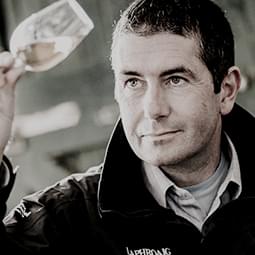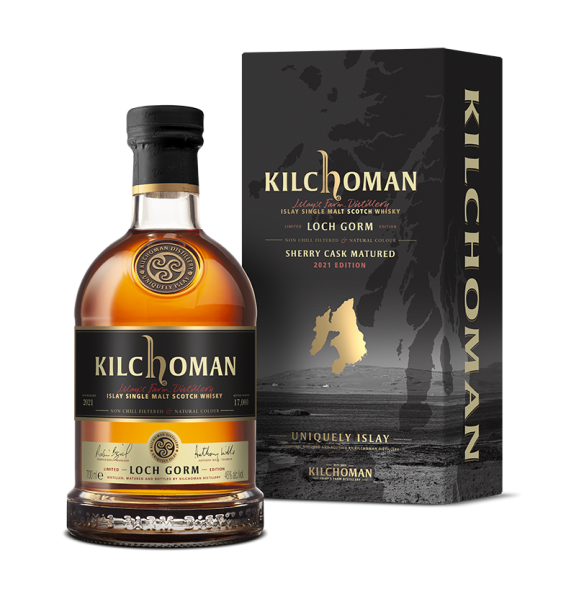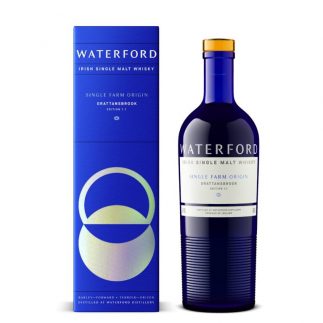14.04.21
Islay & Ireland Tasting; Ardbeg Day 2021; Cutty Sark‘s Adventures; Consumer Whisky Course
Hello again
Well, we‘ve had some April snow here in Scotland but all seems to be improving now. Snow is good for the whisky water table, though it won’t have been enough to make a difference in the whisky production areas.
I‘ve recently mentioned new expressions from a few places and the samples arrived in the last week or so. I‘ve been happily nosing and tasting since then.
 The first one is the new Sherry Oak expression from my former colleagues at Laphroaig, Laphroaig 10 Year Old Sherry Oak Finish (48% abv/ NCF/NAC and about £60 per bottle). Just a couple of weeks ago I joined an online webcast about Laphroaig but ducked out before they tasted this one as I wanted to do my own notes, unaffected by other things I‘d heard. As readers may know, I love a good sherry casked whisky which Laphroaig hasn‘t been known for much in the past. Looking after the marketing of Laphroaig alongside The Glendronach, a longtime sherry beast, was one of the great privileges of my life and I was excited to read that they were introducing this one to their core range. I was also able to e-mail distillery manager, John Campbell, afterwards to ask a few additional questions. First, the tasting note:
The first one is the new Sherry Oak expression from my former colleagues at Laphroaig, Laphroaig 10 Year Old Sherry Oak Finish (48% abv/ NCF/NAC and about £60 per bottle). Just a couple of weeks ago I joined an online webcast about Laphroaig but ducked out before they tasted this one as I wanted to do my own notes, unaffected by other things I‘d heard. As readers may know, I love a good sherry casked whisky which Laphroaig hasn‘t been known for much in the past. Looking after the marketing of Laphroaig alongside The Glendronach, a longtime sherry beast, was one of the great privileges of my life and I was excited to read that they were introducing this one to their core range. I was also able to e-mail distillery manager, John Campbell, afterwards to ask a few additional questions. First, the tasting note:
Appearance: Warm and rich amber/dark caramel with deep orange glints. Tears are slow and clingy, becoming quite widely spaced as the slowly crawl down the glass.
Nose: From the open bottle, rich vanilla, salted caramel and dried vine fruits. In the glass, rich and layered; peat and smoke – yes; char and a bit of tar – yes but also a dark caramel and softly raisiny sweetness. Definite fruit notes; warm and enticing. Golden syrup. Medicinal and sea air too. Freshly shelled nuts. Very noseworthy! With water, more of the raisin fruit emerges; shaved oak staves and cigar boxes; nuttiness againsome savoury and sweet spices e.g. mace; baked honey and barley sugar. Creaminess too.
Palate: Slightly oily, medium mouth weight. Smoke and peat – a little tar and char and peat embers. A chewy texture. Richly roasted barley and „borrowed“ cigar smoke in the throat. Dried fruit and fresh hazelnuts. A hint of sea salt and smoked meats. Seaweed and iodine flavours but dialled back just a little. A slight resinous note also.
Finish: Really long with barley and fruit sweetness, then smoky and mouth-drying; heathery; spices and toasted oak.
Definitely one to curl up with and sip and, in my view, a fine addition to the Laphroaig repertoire. Casks used were 25% whisky fully matured in refill oloroso hoggies and 75% matured for 9 years in ex-bourbon casks then 12 months in first fill oloroso-seasoned hogsheads. John Campbell said it was to be available from about 14th April so it should now be in store.
Other new Laphroaig expressions coming soon are Batch 13, a 10 year old cask strength at 58.2% abv, also NCF/NAC, which was bottled earlier this year and should be available from May. The casks came from two warehouses (8 and 10A)with 75% of them from the bottom stacks and some from the top. John was asked about PX casks and there are plans for Cairdeas cask strength expression in May too. Just in time for this year‘s whisky fesival, virtual yet again, despite some slight easing of lockdown rules from this weekend.He also commented on peatland renewal, indicating that Laphroaig renews about 3 times what it cuts.
Now, as mentioned above, Laphroaig isn‘t really known for it‘s sherry maturation but since the 1960‘s there has been some,  according to John. Later on after the webcast, I was able to ask more about the sherry casks, wondering firstly what percentage of stocks are in sherry wood. Apparently a very small amount – about 1%, according to the typed response. I therefore wondered what sherry cask purchasing intentions are but assume it depends on the success of this new sherry oak finish. The sherry casks Laphroaig uses take a good number of years to be ready to hold spirit. „Yes, we will react to how popular 10 year Sherry is but I would imagine it will increase as a peaty sherry Laphroaig is a very nice dram indeed. Our plan is to grow it over the next few years and become a staple of our core range replacing Triple Wood.“ This led me to ask why discontinue Triple Wood. „We feel 10 year sherry oak can still offer folks the Laphroaig sherry experience, but be an easier progression for folks to make.“ Well, I guess we consumers will make our views known but this new one is a really tasty dram and worth exploring much more than once.
according to John. Later on after the webcast, I was able to ask more about the sherry casks, wondering firstly what percentage of stocks are in sherry wood. Apparently a very small amount – about 1%, according to the typed response. I therefore wondered what sherry cask purchasing intentions are but assume it depends on the success of this new sherry oak finish. The sherry casks Laphroaig uses take a good number of years to be ready to hold spirit. „Yes, we will react to how popular 10 year Sherry is but I would imagine it will increase as a peaty sherry Laphroaig is a very nice dram indeed. Our plan is to grow it over the next few years and become a staple of our core range replacing Triple Wood.“ This led me to ask why discontinue Triple Wood. „We feel 10 year sherry oak can still offer folks the Laphroaig sherry experience, but be an easier progression for folks to make.“ Well, I guess we consumers will make our views known but this new one is a really tasty dram and worth exploring much more than once.
 The second whisky tasted this time is another Islay – the Loch Gorm 2021 Edition (46% abv) from Kilchoman. It‘s another one which uses sherry casks in the maturation. There are 17,000 bottles of it available this time. The distillery used 24 oloroso sherry butts filled in 2011 and 2012. There‘s no age statement though the whisky is at least 9 years old.
The second whisky tasted this time is another Islay – the Loch Gorm 2021 Edition (46% abv) from Kilchoman. It‘s another one which uses sherry casks in the maturation. There are 17,000 bottles of it available this time. The distillery used 24 oloroso sherry butts filled in 2011 and 2012. There‘s no age statement though the whisky is at least 9 years old.
Appearance: Rich, old gold. Tawny and brass highlights. Tears quite swift at first then slower, stickier and more widely spaced.
Nose: From the bottle, sherry and dried fruit sweetness leap out. In glass, smoky, earthy, sweaty wool sock drying by a peat fire. Some char and tar with a nice depth and a bit of fruitiness. Alongside this is smoky bacon crisps / smoked hams. Also a freshness, like smelling peat smoke beside salty sea air. Creamy oak notes. It moves to softer and sweeter becoming more raisiny and sherried with more malted barley aroma as it sits.
With water, it becomes a bit fruitier with less of the harsher smoke but still the sweeter tar notes too. A hint of dark chocolate. This is definitely a dark chocolate match if you want to try a pairing. Saltiness still comes through. Earthy spices, savoury rather than sweet. Polished leather.
Palate: Medium – heavy mouth weight. Slightly oily texture. Smoky, spicy and leathery but with some dried fruit notes. Bonfire embers catch in the throat. Richly roasted barley. Toasty and charred oak notes, the bitterness of dark chocolate and some roasted and salted nuts.
Finish: Long and smoky with bonfire embers; rich roasted barley and leather. It finishes drier plus some grassy and hay flavours linger but leather and peat smoke return. Afterwards, some maritime engine oil fumes at the back of the throat. That‘s not a bad thing! It‘s actually quite an attractive quality here.
I certainly don‘t want to compare the two Islays here but do try it yourselves at home or for your customers (certainly here in the UK, bars etc. are being allowed to open up a bit). They are both good but very different.
And that last statement leads me further west to Waterford Distillery in Ireland, home of the terroir experiments. The latest two they kindly sent over are Grattansbrook and Hook Head. Bear in mind that both of these whiskies are young. In both instances, I nosed and tasted before checking the cask types used. An interesting exercise will be to compare whisky taken from the same casks some years hence.
Grattansbrook: Edition 1.1 – UK only (50% abv/ NCF). The whisky is the first release from the 2015 harvest of Taberna barley  from Grattansbrook farm in Co. Kildare. Situated on a flat, fertile flood plain of the River Barrow, Andrew Bergin’s family have farmed here for nine generations. The farm follows the ‘Farming for Nature’ protocol, managing the land to bring biological benefits to its limestone soil. Grattansbrook 1.1 has been aged for over three years and ten months in multiple casks including first-fill, virgin US & French oak.
from Grattansbrook farm in Co. Kildare. Situated on a flat, fertile flood plain of the River Barrow, Andrew Bergin’s family have farmed here for nine generations. The farm follows the ‘Farming for Nature’ protocol, managing the land to bring biological benefits to its limestone soil. Grattansbrook 1.1 has been aged for over three years and ten months in multiple casks including first-fill, virgin US & French oak.
Appearance: Bright straw gold. Pale brass and tawny highlights. Tears are clingy and close at first then speed up.
Nose: Nose prickling at first, even at a slight distance. Rich malty barley notes but still spiritous (it‘s youthful). Touch of lemon juice and baked light fruits. Little bit of oak and brioche/bread notes (yeast). With water it look oilier in the glass at first. Softer notes swith a tiny hint of struck match – very fleeting. Sponge cake. Drier than Hook Head. Soft candy sweets (Dolly Mixtures for UK folks!). Barley sugar and icing. Sweet soft oak notes and a touch of vegetable cooking water.
Palate: Slightly oily. Medium mouth weight. Some barley and wood sweetness, marzipan. Touch of oak and light pepper. A little hint of oak toast.
Finish: Medium length with a lingering sweetness. Then drying and some toasty oak.
 Hook Head: Edition 1.1 is available in a number of markets. Other Single Farm Origin bottlings are destined for other specific European countries. We‘re told, „The lighthouse at Hook Head, an extreme maritime terroir, stands resolute against the full force of the Atlantic Ocean on Ireland’s southern coast. Exposed to salt-laden storms, Martin Foley’s barley grows on clay/loam soils of the Elton series.“ So now you know. This addition to the Single Farm Origin series uses Irish ‘Propino’ barley from the 2015 harvest at Hook Head Farm. The spirit was matured for 3 years and 8 months in a selection of casks, which include first-fill bourbon, virgin American oak, and French oak including Margaux and a vin doux naturel.
Hook Head: Edition 1.1 is available in a number of markets. Other Single Farm Origin bottlings are destined for other specific European countries. We‘re told, „The lighthouse at Hook Head, an extreme maritime terroir, stands resolute against the full force of the Atlantic Ocean on Ireland’s southern coast. Exposed to salt-laden storms, Martin Foley’s barley grows on clay/loam soils of the Elton series.“ So now you know. This addition to the Single Farm Origin series uses Irish ‘Propino’ barley from the 2015 harvest at Hook Head Farm. The spirit was matured for 3 years and 8 months in a selection of casks, which include first-fill bourbon, virgin American oak, and French oak including Margaux and a vin doux naturel.
Appearance: Rich sunshine gold. Brass and light orange highlights. Tears, again, clingy and close at first. Slightly oily appearance.
Nose: Rich barley notes there but nose is generally richer and deeper than Grattansbrook.It‘s a much sweeter nose too; a touch vinous with some icing sugar. Soft baked fruits with a dab of sultana and oak. Earthy but as it sits it gets sweeter again. With water, still the marshmallow sweetness. Dried fruit a little more to the fore. Soft., almost sappy note. A slight nuttiness and maybe a bit of sulphur here too.
Palate: Slightly oily and heavier mouth weight than Grattansbrook. Despite the nose, I found it drier than expected and more peppery. Some almond notes.
Finish: Short – medium length; dry with oak tannins. Slight sour cherry bitterness and sappy, „green“ notes.
Although I preferred the Hook Head nose, I thought the Grattansbrook had more palate nuance going for it but will need to try them again. I gave a dram of both to an avowed Irish whiskey fan I know and he preferred the Hook Head.
Both whiskies are around £70 – £75/bottle in the UK and 70 – 80 euros in European markets.One of these days I must get out all my Waterford samples and do a comparison tasting. An interesting one for you at home or for your Irish Whiskey customers.
Do remember, if you look at a bottle you have you‘ll find its TÉIREOIR code, which when entered online gives you reams of information on „the whisky, including barrel breakdown, barley agronomy, farm origin maps, distillation data, farm photography and field audio“. 
Just today, news arrived of Ardbeg‘s intentions for its virtual Feis day at this years Islay Festival of Malt and Music (Feis Ile) and it features Shortie the Jack Russell dog and a „flavour breathing dragon“. What?! Ardbeg Day is 5th June and find out more on the Ardbeg website. As ever, Ardbeg‘s great sense of humour pops up in the naming of this year‘s Feis bottling – Ardbeg Scorch. We are told it‘s, „Matured in heavily charred ex-Bourbon American Oak casks and with lair upon lair of flavour“. That pun is most definitely intended. Those in the UK who are Ardbeg Committee members can acquire the Committee Edition of this bottling on 27th April. The Ardbeg Day Edition (just as tasty) will be available to Members and non-Members from 25th May. Again, if not a Committee Member, check online in due course for more info.
 A little while back I had an e-mail from an old industry acquaintance (she‘s not old – we‘ve just been acquainted for a long time) telling me about a consumer (not trade) whisky course she has set up with a US partner. Unlike the Whisky Ambassador courses it‘s not an officially accredited one for people in the hospitality trades but there‘s plenty of good content in it and it‘s done online so can be useful to recommend to your consumer customers. The lady in question is Ann Miller and, like me, she both worked in the Scotch Whisky industry for years and has been educating/training people about it for a long time. The company is The Spirits Club Academy and intends „to make Scotch whisky more accessible to whisky novices around the world“. They do say no experience is necessary, just an interest. Taste of Scotch, is the online introductory course about Scotch Whisky and is free of charge. The second part involves a fee. Find out more on https://spiritsclub.teachable.com/p/talking-scotch . The course includes online lectures, downloadable documents and a number of tastings, though samples for the tastings are not included as they cannot ship samples. There is a list of whiskies to be used, though, if people can acquire their own.
A little while back I had an e-mail from an old industry acquaintance (she‘s not old – we‘ve just been acquainted for a long time) telling me about a consumer (not trade) whisky course she has set up with a US partner. Unlike the Whisky Ambassador courses it‘s not an officially accredited one for people in the hospitality trades but there‘s plenty of good content in it and it‘s done online so can be useful to recommend to your consumer customers. The lady in question is Ann Miller and, like me, she both worked in the Scotch Whisky industry for years and has been educating/training people about it for a long time. The company is The Spirits Club Academy and intends „to make Scotch whisky more accessible to whisky novices around the world“. They do say no experience is necessary, just an interest. Taste of Scotch, is the online introductory course about Scotch Whisky and is free of charge. The second part involves a fee. Find out more on https://spiritsclub.teachable.com/p/talking-scotch . The course includes online lectures, downloadable documents and a number of tastings, though samples for the tastings are not included as they cannot ship samples. There is a list of whiskies to be used, though, if people can acquire their own.
Finishing this time on a note about Cutty Sark. They sent out a note on their global campaign, The Spirit of Adventure  accompanied by a compass – neat idea – to encourage people to create their own adventures and „follow their dreams, no matter how challenging they may be“. It‘s going to feature large on social media with local activities and sponsorships so maybe more news later. Check out more on the Cutty Sark Whisky Facebook page and Instagram at https://www.instagram.com/cuttysarkwhisky/?hl=en.I took this pic on my phone which is why it’s not the best.
accompanied by a compass – neat idea – to encourage people to create their own adventures and „follow their dreams, no matter how challenging they may be“. It‘s going to feature large on social media with local activities and sponsorships so maybe more news later. Check out more on the Cutty Sark Whisky Facebook page and Instagram at https://www.instagram.com/cuttysarkwhisky/?hl=en.I took this pic on my phone which is why it’s not the best.
 With the easing of lockdown I‘m hoping to start having adventures before too much longer. Our whisky islands may be one of them. It would also be good to get back my clients for tailor-made whisky tours. It’s been a quiet year…Fingers crossed!
With the easing of lockdown I‘m hoping to start having adventures before too much longer. Our whisky islands may be one of them. It would also be good to get back my clients for tailor-made whisky tours. It’s been a quiet year…Fingers crossed!
Back at the end of this month and happy dramming till then.
Caroline
Comments